Abstract
Choroideremia (McK30310), an X-linked hereditary retinal dystrophy, causes night-blindness, progressive peripheral visual field loss, and, ultimately, central blindness in affected males. The location of choroideremia on the X chromosome is unknown. We have used restriction fragment length polymorphisms from the X chromosome to determine the regional localization of choroideremia by linkage analysis in families with this disease. One such polymorphic locus, DXYS1, located on the long arm (Xq) within bands q13-q21, shows no recombination with choroideremia at lod = 5.78. Therefore, with 90% probability, choroideremia maps within 9 centiMorgans (cM) of DXYS1. Another polymorphic locus, DXS11, located within Xq24-q26, also shows no recombination with choroideremia, although at a smaller lod score of 1.54 (90% probability limit theta less than 30 cM). This linkage with DXS11, a marker that is distal to DXYS1, suggests that the locus for choroideremia is also distal to DXYS1 and lies between these two markers in the region Xq13-q24. These results provide regional mapping for the disease that may be useful for prenatal diagnosis and, perhaps ultimately, for isolating the gene locus for choroideremia.
Full text
PDF
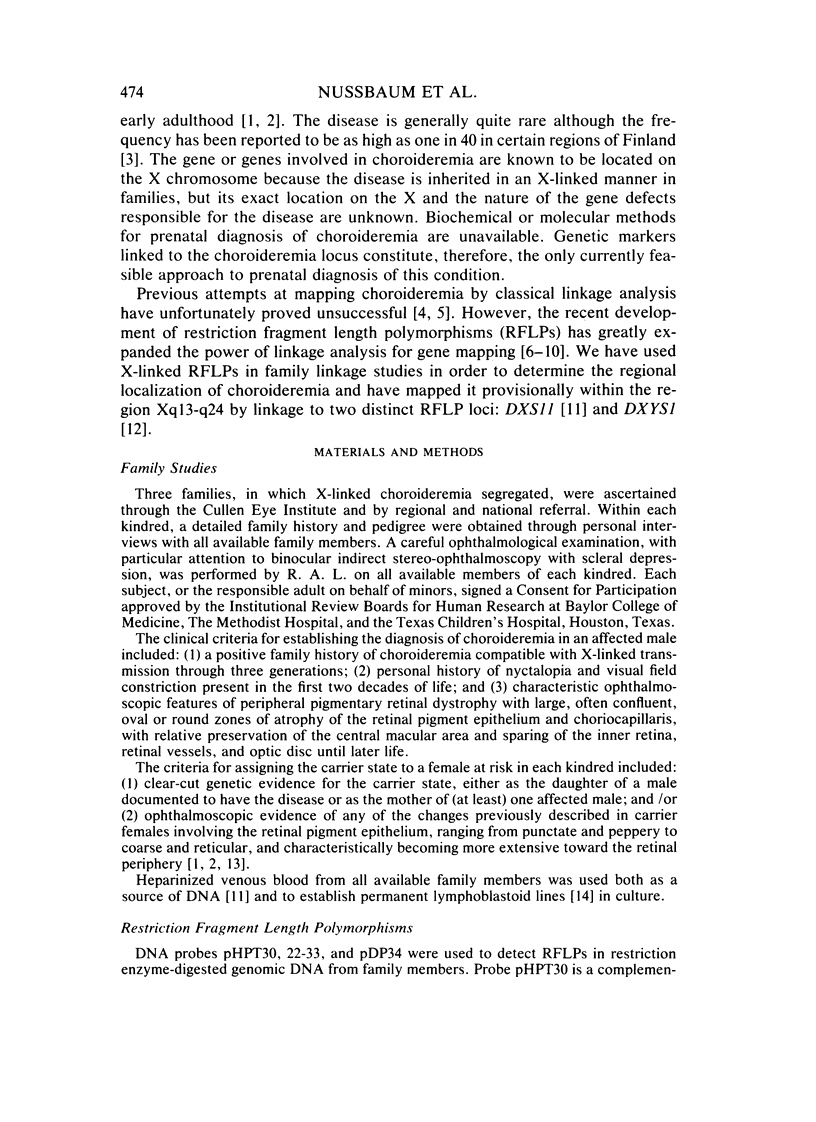
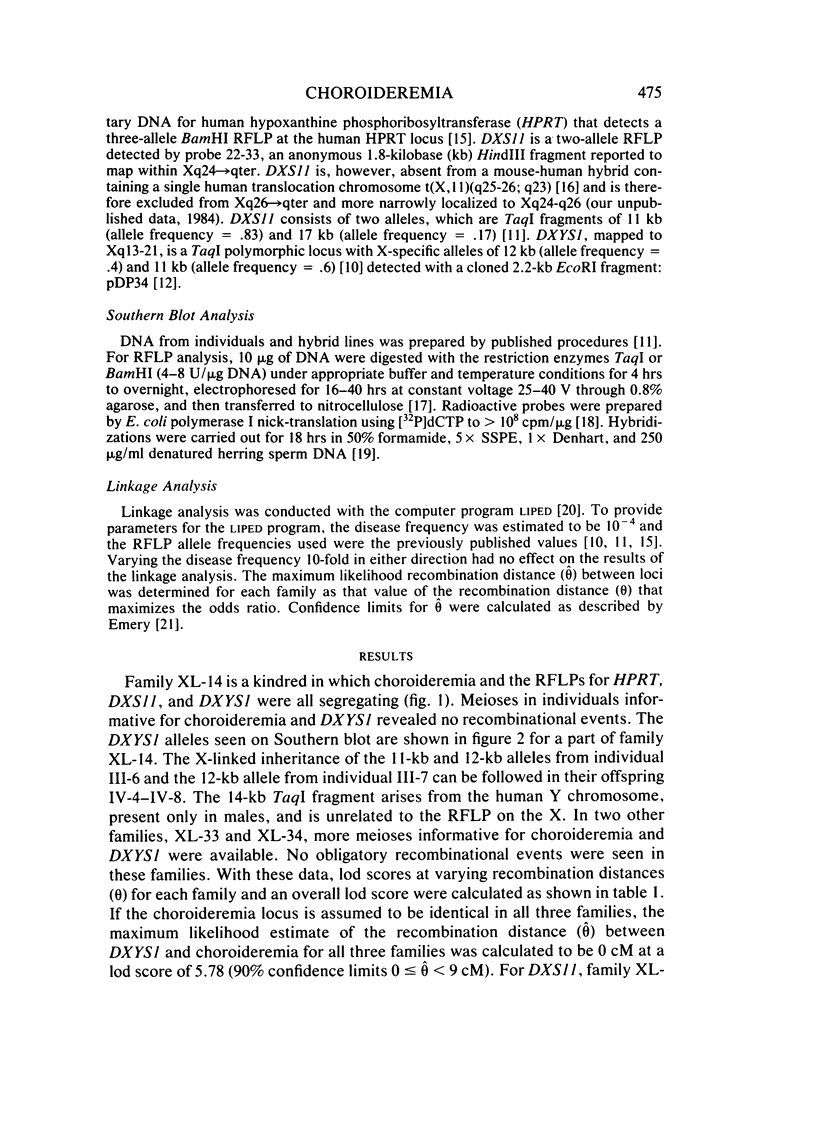
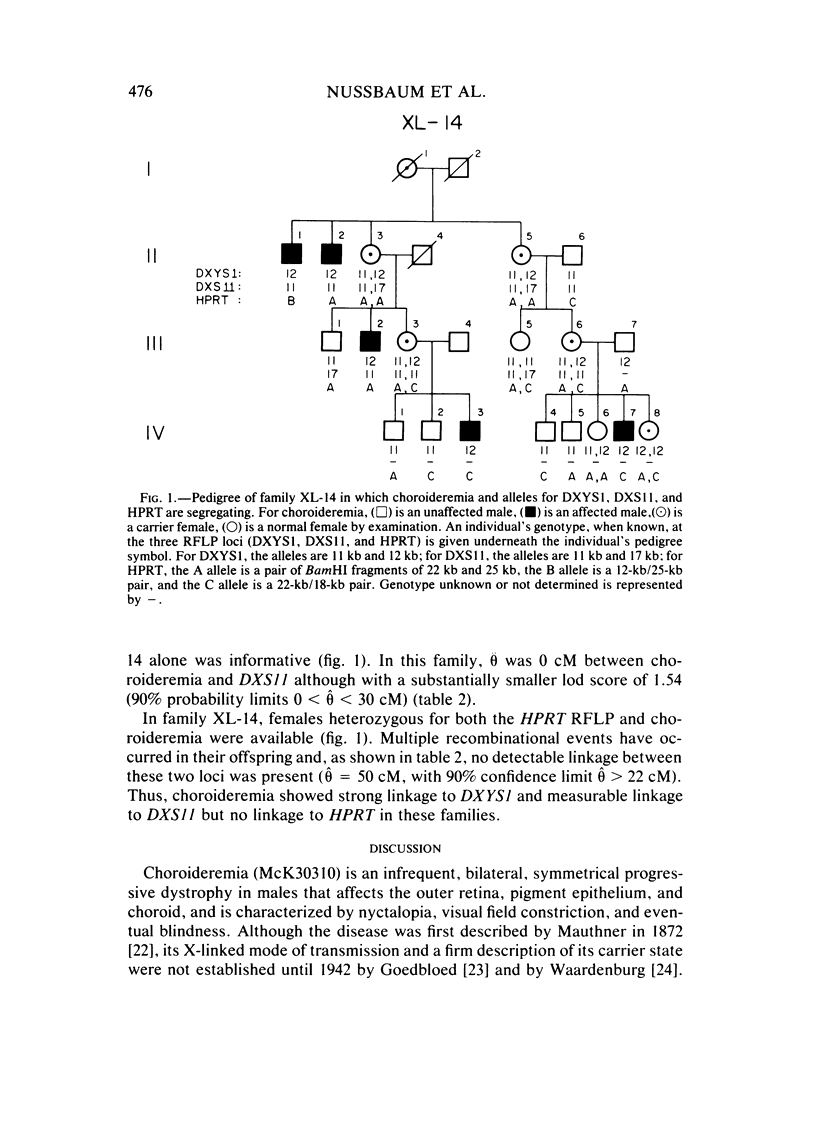

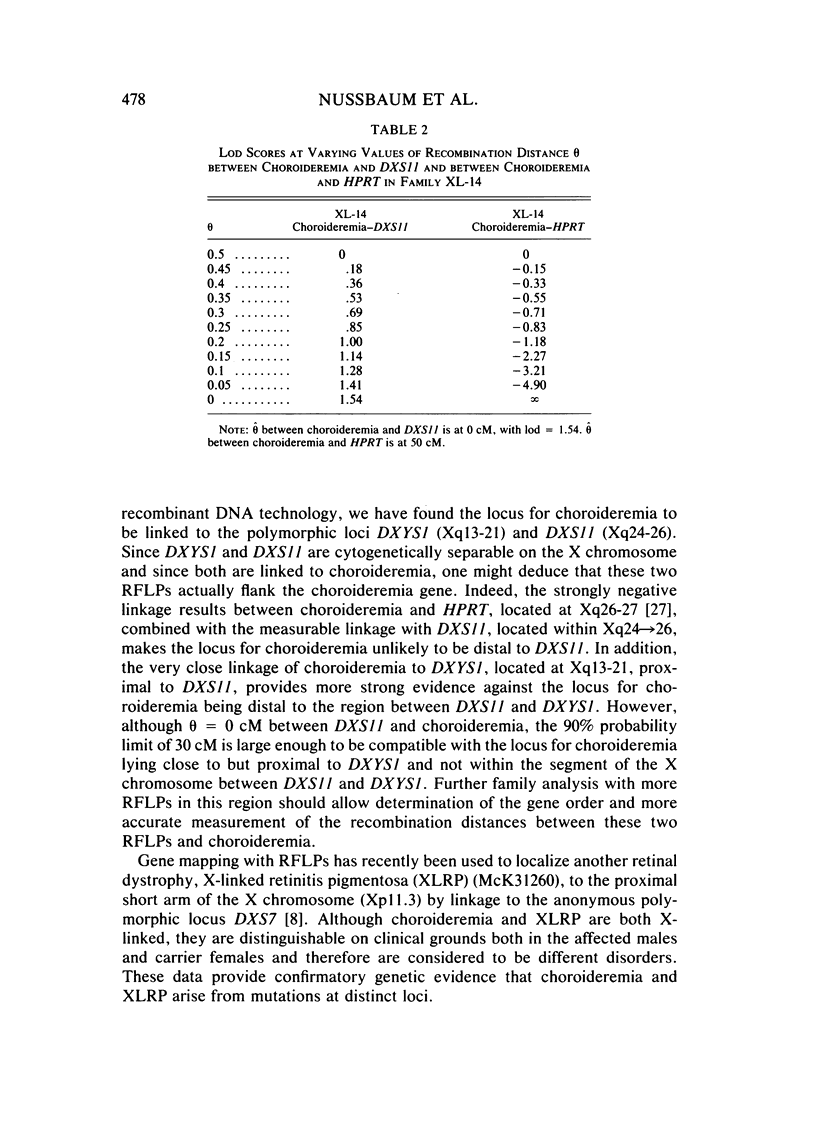
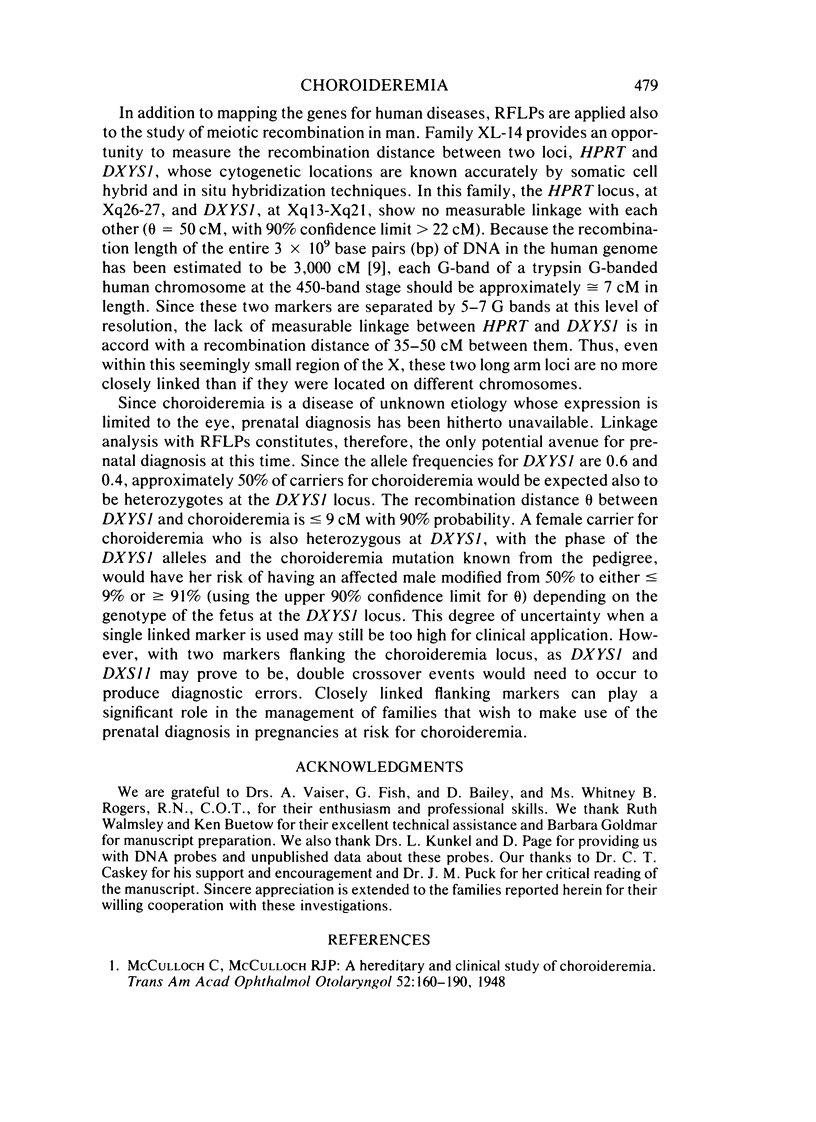
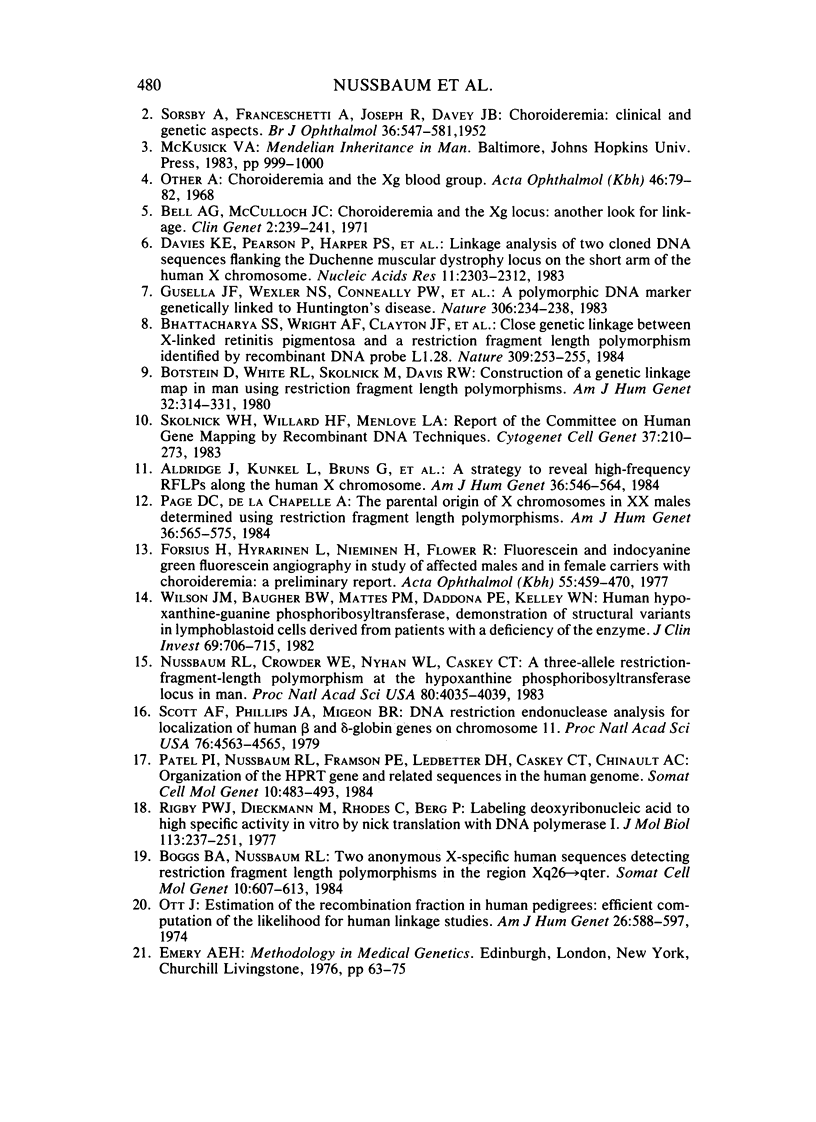
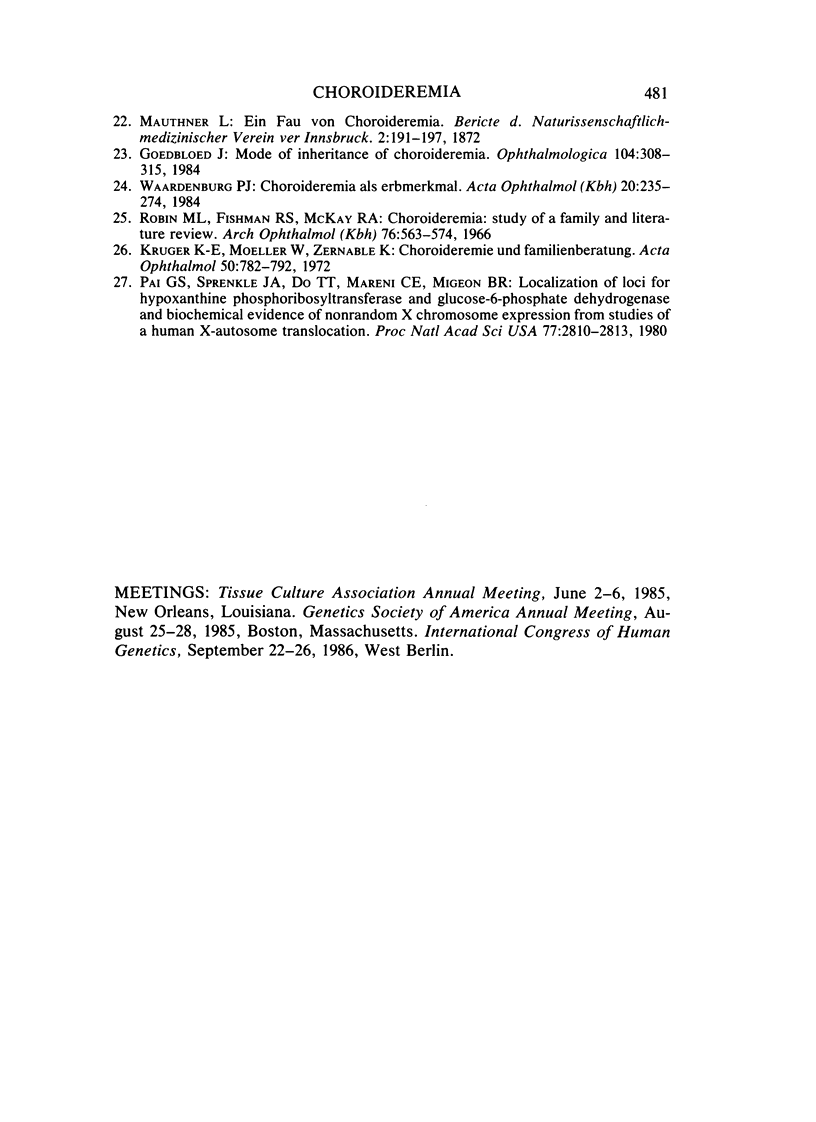
Images in this article
Selected References
These references are in PubMed. This may not be the complete list of references from this article.
- Aldridge J., Kunkel L., Bruns G., Tantravahi U., Lalande M., Brewster T., Moreau E., Wilson M., Bromley W., Roderick T. A strategy to reveal high-frequency RFLPs along the human X chromosome. Am J Hum Genet. 1984 May;36(3):546–564. [PMC free article] [PubMed] [Google Scholar]
- Bell A. G., McCulloch J. C. Choroideremia and the Xg locus: another look for linkage. Clin Genet. 1971;2(4):239–241. doi: 10.1111/j.1399-0004.1971.tb00283.x. [DOI] [PubMed] [Google Scholar]
- Bhattacharya S. S., Wright A. F., Clayton J. F., Price W. H., Phillips C. I., McKeown C. M., Jay M., Bird A. C., Pearson P. L., Southern E. M. Close genetic linkage between X-linked retinitis pigmentosa and a restriction fragment length polymorphism identified by recombinant DNA probe L1.28. Nature. 1984 May 17;309(5965):253–255. doi: 10.1038/309253a0. [DOI] [PubMed] [Google Scholar]
- Boggs B. A., Nussbaum R. L. Two anonymous X-specific human sequences detecting restriction fragment length polymorphisms in region Xq26----qter. Somat Cell Mol Genet. 1984 Nov;10(6):607–613. doi: 10.1007/BF01535226. [DOI] [PubMed] [Google Scholar]
- Botstein D., White R. L., Skolnick M., Davis R. W. Construction of a genetic linkage map in man using restriction fragment length polymorphisms. Am J Hum Genet. 1980 May;32(3):314–331. [PMC free article] [PubMed] [Google Scholar]
- Davies K. E., Pearson P. L., Harper P. S., Murray J. M., O'Brien T., Sarfarazi M., Williamson R. Linkage analysis of two cloned DNA sequences flanking the Duchenne muscular dystrophy locus on the short arm of the human X chromosome. Nucleic Acids Res. 1983 Apr 25;11(8):2303–2312. doi: 10.1093/nar/11.8.2303. [DOI] [PMC free article] [PubMed] [Google Scholar]
- Forsius H., Hyvärinen L., Nieminen H., Flower R. Fluorescein and indocyanine green fluorescence angiography in study of affected males and in female carriers with choroidermia. A preliminary report. Acta Ophthalmol (Copenh) 1977 Jun;55(3):459–470. doi: 10.1111/j.1755-3768.1977.tb06123.x. [DOI] [PubMed] [Google Scholar]
- Gusella J. F., Wexler N. S., Conneally P. M., Naylor S. L., Anderson M. A., Tanzi R. E., Watkins P. C., Ottina K., Wallace M. R., Sakaguchi A. Y. A polymorphic DNA marker genetically linked to Huntington's disease. Nature. 1983 Nov 17;306(5940):234–238. doi: 10.1038/306234a0. [DOI] [PubMed] [Google Scholar]
- Krüger K. E., Moeller W., Zernahle K. Chorioideremie und familienberatung. Acta Ophthalmol (Copenh) 1972;50(6):782–792. doi: 10.1111/j.1755-3768.1972.tb06617.x. [DOI] [PubMed] [Google Scholar]
- Nussbaum R. L., Crowder W. E., Nyhan W. L., Caskey C. T. A three-allele restriction-fragment-length polymorphism at the hypoxanthine phosphoribosyltransferase locus in man. Proc Natl Acad Sci U S A. 1983 Jul;80(13):4035–4039. doi: 10.1073/pnas.80.13.4035. [DOI] [PMC free article] [PubMed] [Google Scholar]
- Other A. Choroideremia and the Xg blood group. Acta Ophthalmol (Copenh) 1968;46(1):79–82. doi: 10.1111/j.1755-3768.1968.tb02498.x. [DOI] [PubMed] [Google Scholar]
- Ott J. Estimation of the recombination fraction in human pedigrees: efficient computation of the likelihood for human linkage studies. Am J Hum Genet. 1974 Sep;26(5):588–597. [PMC free article] [PubMed] [Google Scholar]
- Page D. C., de la Chapelle A. The parental origin of X chromosomes in XX males determined using restriction fragment length polymorphisms. Am J Hum Genet. 1984 May;36(3):565–575. [PMC free article] [PubMed] [Google Scholar]
- Pai G. S., Sprenkle J. A., Do T. T., Mareni C. E., Migeon B. R. Localization of loci for hypoxanthine phosphoribosyltransferase and glucose-6-phosphate dehydrogenase and biochemical evidence of nonrandom X chromosome expression from studies of a human X-autosome translocation. Proc Natl Acad Sci U S A. 1980 May;77(5):2810–2813. doi: 10.1073/pnas.77.5.2810. [DOI] [PMC free article] [PubMed] [Google Scholar]
- Patel P. I., Nussbaum R. L., gramson P. E., Ledbetter D. H., Caskey C. T., Chinault A. C. Organization of the HPRT gene and related sequences in the human genome. Somat Cell Mol Genet. 1984 Sep;10(5):483–493. doi: 10.1007/BF01534853. [DOI] [PubMed] [Google Scholar]
- Rigby P. W., Dieckmann M., Rhodes C., Berg P. Labeling deoxyribonucleic acid to high specific activity in vitro by nick translation with DNA polymerase I. J Mol Biol. 1977 Jun 15;113(1):237–251. doi: 10.1016/0022-2836(77)90052-3. [DOI] [PubMed] [Google Scholar]
- Rubin M. L., Fishman R. S., McKay R. A. Choroideremia. Study of a family and literature review. Arch Ophthalmol. 1966 Oct;76(4):563–574. doi: 10.1001/archopht.1966.03850010565015. [DOI] [PubMed] [Google Scholar]
- SORSBY A., FRANCESCHETTI A., JOSEPH R., DAVEY J. B. Choroideremia; clinical and genetic aspects. Br J Ophthalmol. 1952 Oct;36(10):547–581. doi: 10.1136/bjo.36.10.547. [DOI] [PMC free article] [PubMed] [Google Scholar]
- Scott A. F., Phillips J. A., 3rd, Migeon B. R. DNA restriction endonuclease analysis for localization of human beta- and delta-globin genes on chromosome 11. Proc Natl Acad Sci U S A. 1979 Sep;76(9):4563–4565. doi: 10.1073/pnas.76.9.4563. [DOI] [PMC free article] [PubMed] [Google Scholar]
- Skolnick M. H., Willard H. F., Menlove L. A. Report of the Committee on Human Gene Mapping by Recombinant DNA Techniques. Cytogenet Cell Genet. 1984;37(1-4):210–273. doi: 10.1159/000132011. [DOI] [PubMed] [Google Scholar]
- Wilson J. M., Baugher B. W., Mattes P. M., Daddona P. E., Kelley W. N. Human hypoxanthine-guanine phosphoribosyltransferase. Demonstration of structural variants in lymphoblastoid cells derived from patients with a deficiency of the enzyme. J Clin Invest. 1982 Mar;69(3):706–715. doi: 10.1172/JCI110499. [DOI] [PMC free article] [PubMed] [Google Scholar]



